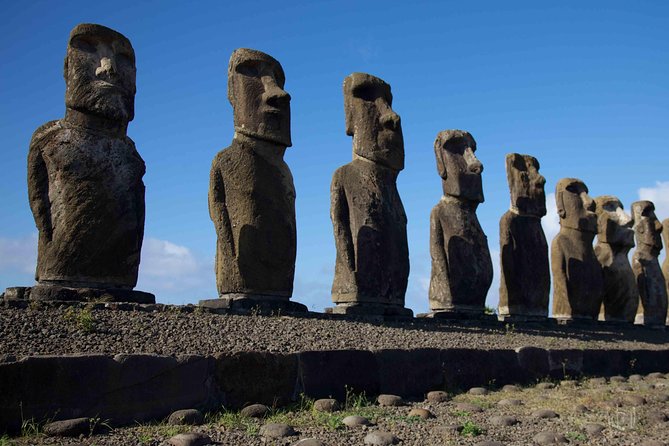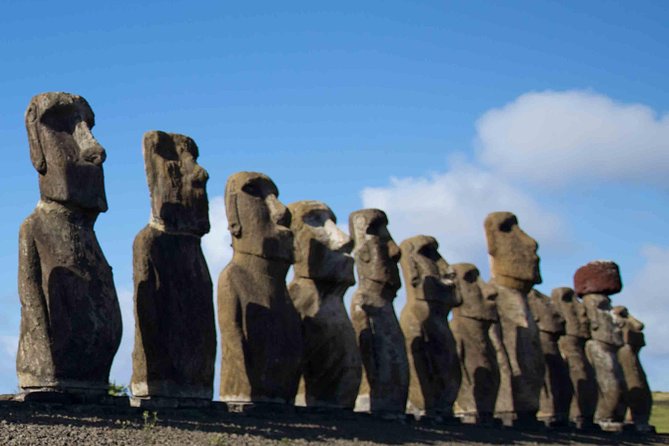Symbolizing both mystery and resilience, the Seven Moais in Easter Island captivate all who set eyes upon them. Standing stoically against the test of time, these ancient statues hold within them tales of a civilization long past.
As the sun sets over the Pacific horizon, casting a golden hue upon the Moais, whispers of their secrets beckon to be unraveled. Each Moai, with its unique features and enigmatic expressions, serves as a silent guardian of a history waiting to be unveiled, promising a journey that transcends time itself.
Good To Know

- The Seven Moais symbolize ancestral connections and societal structure.
- Construction methods demonstrate the Rapa Nui’s impressive engineering skills.
- The statues signify spiritual beliefs, protection, and territorial boundaries.
- Preservation efforts ensure the conservation and cultural significance of the Seven Moais.
Historical Significance
The Seven Moais in Easter Island hold immense historical significance, shedding light on the ancient civilization that once thrived in this remote location. These massive stone statues, carved by the Rapa Nui people centuries ago, stand as a testament to their craftsmanship, engineering skills, and cultural beliefs.
Each Moai is a unique representation of a deceased ancestor, with the tallest reaching up to 33 feet in height and weighing around 82 tons. These statues were strategically placed along the coastline, facing inland to overlook and protect the Rapa Nui community.
The Seven Moais not only showcase the artistic prowess of the Rapa Nui but also offer insight into their spiritual practices and societal structure.
Find more activities and experiences we've covered in Hanga Roa.
Cultural Background

Centuries before modern times, the Rapa Nui people on Easter Island cultivated a rich and intricate cultural background intertwined with their daily lives and spiritual beliefs. This culture revolved around the concept of mana, a spiritual energy believed to exist in people, animals, and even inanimate objects.
The moais, the iconic colossal statues found on the island, weren’t just stone structures but representations of ancestors imbued with this mana. The Rapa Nui society was hierarchical, with chiefs overseeing the construction of these statues to display power and prestige. These moais weren’t only symbols of authority but also served as focal points for community gatherings and rituals, reflecting the deep spiritual connection the Rapa Nui people had with their ancestors and the natural world.
Construction Techniques
Using primitive tools like stone picks and ropes made from plant fibers, the Rapa Nui people implemented ingenious methods to carve and transport the massive moai statues across Easter Island. These techniques have fascinated researchers for centuries, shedding light on the incredible capabilities of ancient civilizations.
Key Construction Techniques:
Stone Carving: The Rapa Nui artisans used stone picks to meticulously shape the volcanic rock into intricate moai statues.
Transportation: Employing a system of ropes and sledges, the islanders moved the heavy statues from the quarry to their final locations with impressive precision.
Erection: Once at their destination, the moai were stood upright using a combination of ramps and human manpower, showcasing the community’s collaborative efforts.
Symbolic Meanings
Carving the volcanic rock with precision and moving the colossal statues with intricate systems, the Rapa Nui people imbued the Seven Moais of Easter Island with profound symbolic meanings. Each Moai is believed to represent a deceased ancestor, serving as a connection between the living and the spirits of the past.
The direction in which the statues face is thought to symbolize protection and guidance for the community, with their backs to the sea and their faces towards the villages. The size and stature of the Moais are seen as a reflection of the importance and status of the ancestor they represent.
Plus, the positioning of the Moais along the coast is thought to mark territorial boundaries and sacred spaces, reinforcing the spiritual significance of these enigmatic figures.
- 2-Day Private Tour Easter Island Highlights Complete Discovery
- Private Full-Day Easter Island Highlights North and West
- Private Easter Island Full-Day Tour
- Private Full-Day Easter Island Highlights South and East
- Easter Island Full-Day Tour: Ahu Tongariki, Rano Raraku and Anakena Beach
- Private Full-Day Easter Island Moai Monuments Tour
Preservation Efforts
Preservation efforts for the Seven Moais in Easter Island have been a collaborative endeavor involving local authorities, conservation experts, and community members.
Key Preservation Efforts:
Restoration Projects: Ongoing initiatives aim to stabilize and restore the moais to prevent further deterioration.
Environmental Monitoring: Continuous monitoring of the surrounding environment helps protect the statues from natural elements and erosion.
Community Involvement: Engaging the local community in preservation efforts fosters a sense of ownership and ensures the sustainability of conservation projects.
These combined efforts play a crucial role in safeguarding the cultural heritage of the Seven Moais for future generations to appreciate and admire.
Tourist Attractions
Nestled along the picturesque shores of Hanga Roa in Chile, the Seven Moais in Easter Island stand as captivating tourist attractions awaiting exploration. These towering stone figures, each with a unique expression and meaning, draw visitors from around the world to marvel at their mysterious presence.
As travelers wander among the Moais, they can feel the ancient energy that emanates from these impressive statues, each telling a story of the island’s rich history. The tranquil surroundings of the site provide a peaceful setting for reflection and contemplation, making it a perfect spot for those seeking a deeper connection with the island’s past.
Whether admiring the sunrise or sunset against the Moais’ silhouettes, visitors are sure to be mesmerized by the beauty and allure of these iconic landmarks.
Local Legends
Among the whispers of the wind and the ancient stones, tales of captivating local legends intertwine with the enigmatic presence of the Seven Moais in Easter Island.
Legends of the Birdman Cult: Explore the mythological stories surrounding the Tangata Manu, a competition where warriors would race to retrieve the first egg of the season from a nearby island.
The Mystery of the Moving Moais: Explore the mystery of how these massive statues were transported across the island, with some locals believing they ‘walked’ to their final locations.
The Curse of the Seven Moais: Discover the chilling legend that tells of a curse placed upon those who try to disturb or remove these sacred statues, warning of misfortune and tragedy.
Frequently Asked Questions
How Long Does It Take to Reach Easter Island From Mainland Chile?
It takes approximately 5 hours to fly from mainland Chile to Easter Island. The flight offers stunning aerial views and is the most common way to reach this remote and mysterious island in the Pacific Ocean.
Are There Any Restrictions on Taking Photos of the Seven Moais?
Taking photos of the Seven Moais in Easter Island is allowed, however, visitors should respect the site and avoid climbing on the statues. It’s recommended to capture the beauty of the moais while being mindful of the cultural significance.
Is There a Specific Reason Why the Seven Moais Are Facing Towards the Ocean?
Facing towards the ocean, the Seven Moais in Easter Island hold a significant cultural and historical purpose. It is believed that their orientation symbolizes protection and guidance for the community, connecting them with their ancestors and the spirit world.
Are There Any Traditional Ceremonies or Rituals Associated With the Seven Moais?
Traditional ceremonies and rituals are deeply intertwined with the seven moais, reflecting ancestral practices and cultural significance. These ceremonies often involve offerings, chants, and dances, symbolizing respect for ancestors, community unity, and spiritual connections with the land and sea.
How Has the Local Community Been Involved in the Preservation of the Seven Moais?
The local community has actively preserved the Seven Moais by participating in restoration efforts, educating visitors on the historical significance, and enforcing regulations to protect these sacred statues, ensuring their cultural and archaeological value endures for future generations.
The Sum Up
To sum it up, the Seven Moais in Easter Island offer a captivating glimpse into the island’s rich history and cultural heritage.
These ancient stone statues stand as enduring symbols of mystery and wonder, drawing visitors from around the world to marvel at their beauty and significance.
With their intricate details, symbolic meanings, and fascinating construction techniques, the Moais continue to be a source of fascination and inspiration for all who visit this awe-inspiring destination.
More Tour Reviews in Hanga Roa
Looking for something different? Other Hanga Roa activities we've written about
- 22 Best Tours In Hanga Roa
- 6 Best 2 Day Tours In Hanga Roa
- 7 Best Full-Day Tours In Hanga Roa
- 2 Best Wine Tours In Hanga Roa
- Best Private Driver Services In Hanga Roa
- Best Private Driver Services In Hanga Roa
- Best Boat Tours And Cruises In Hanga Roa
- 3 Best City Tours In Hanga Roa
- Easter Island Airport Shuttle Transfer
- North Coast of Easter Island: Full Day Private Trekking Tour
- 8-Days Unique Experience in Easter Island & Chilean Patagonia
- Private 5 Days Tour in Easter Island
